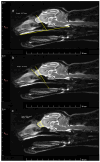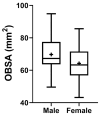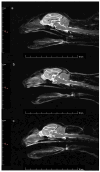Preliminary Findings on the Morphometric Characteristics of the Olfactory Bulb in the Cat
- PMID: 39765495
- PMCID: PMC11672697
- DOI: 10.3390/ani14243590
Preliminary Findings on the Morphometric Characteristics of the Olfactory Bulb in the Cat
Abstract
The aim of this preliminary study was to morphologically and dimensionally characterize the cat's olfactory bulb in the sagittal plane and to establish potential relationships with the cranial conformation, based on the study of in vivo MRI images. Midsagittal and transverse T2-weighted images of the head of 40 cats subjected to MRI were selected. For each animal, the skull index was calculated to classify the cranial conformation. Then, for the olfactory bulb, the angle was calculated, the orientation was determined, and the sagittal section area was measured. It was established that animals classified as brachycephalic have more compact olfactory bulbs, with smaller cross-sectional areas, ventral orientation and smaller angles established with the line that goes from the hard palate and the intercondylar notch of the foramen magnum. Animals classified as dolichocephalic have more globose and wider olfactory bulbs, dorsal orientation, and larger angles. Mesocephalic animals present an intermediate position. Males and younger adult animals have olfactory bulbs with larger cross-sectional areas than females and older animals. This work allows for the preliminarily characterization of the olfactory bulb in cats in the sagittal plane, and the correlations identified with other head structures open doors for the use of the bulb as an early indicator for the establishment of alterations of varied etiology.
Keywords: MRI; cat; companion animals; head conformation; morphometry; olfactory bulb; olfactory system.
Conflict of interest statement
The authors declare that the research was conducted in the absence of any commercial or financial relationships that could be construed as a potential conflict of interest.
Figures












Similar articles
-
Effect of brachycephalic, mesaticephalic, and dolichocephalic head conformations on olfactory bulb angle and orientation in dogs as determined by use of in vivo magnetic resonance imaging.Am J Vet Res. 2012 Jul;73(7):946-51. doi: 10.2460/ajvr.73.7.946. Am J Vet Res. 2012. PMID: 22738044
-
The Olfactory Bulb in Companion Animals-Anatomy, Physiology, and Clinical Importance.Brain Sci. 2023 Apr 24;13(5):713. doi: 10.3390/brainsci13050713. Brain Sci. 2023. PMID: 37239185 Free PMC article. Review.
-
A ventral glomerular deficit in Parkinson's disease revealed by whole olfactory bulb reconstruction.Brain. 2017 Oct 1;140(10):2722-2736. doi: 10.1093/brain/awx208. Brain. 2017. PMID: 28969383 Free PMC article.
-
Radiographic analysis of skull in Van Cats, British Shorthairs and Scottish Folds.Anat Histol Embryol. 2023 May;52(3):512-518. doi: 10.1111/ahe.12909. Epub 2023 Feb 15. Anat Histol Embryol. 2023. PMID: 36793158
-
Development of the human olfactory system.Handb Clin Neurol. 2019;164:29-45. doi: 10.1016/B978-0-444-63855-7.00003-4. Handb Clin Neurol. 2019. PMID: 31604554 Review.
References
-
- Kavoi B.M., Jameela H. Comparative morphometry of the olfactory bulb, tract and stria in the human, dog and goat. Int. J. Morphol. 2011;29:939–946. doi: 10.4067/S0717-95022011000300047. - DOI
Grants and funding
LinkOut - more resources
Full Text Sources
Miscellaneous

